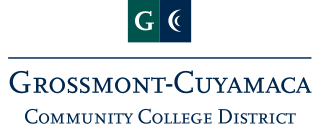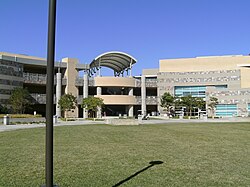
The Community College of Philadelphia (CCP) is a public community college with campuses throughout Philadelphia. The college was founded in 1965 and is accredited by the Middle States Commission on Higher Education. It offers over 100 associate degree and certificate programs through its four locations.

Wesleyan College is a private, liberal arts women's college in Macon, Georgia, United States. Founded in 1836, Wesleyan was the first college in the world chartered to grant degrees to women.
Santa Rosa Junior College (SRJC) is a public community college in Santa Rosa, California with an additional campus in Petaluma and centers in surrounding Sonoma County. Santa Rosa Junior College was modeled as a feeder school for the University of California system. SRJC is operated by the Sonoma County Community College District.

Helix High School, in La Mesa, California, is a charter high school built in 1952. It received its charter in 1998. Part of the Grossmont Union High School District, it serves a mid-level socioeconomic community and has a student body of approximately 2,400 pupils. Helix serves parts of La Mesa, Lemon Grove, and Spring Valley; however, as a charter school, all high school students in the state of California are eligible to attend.

Muskegon Community College (MCC) is a public community college in Muskegon, Michigan. The college offers 49 associate degree programs and 33 certificate programs. The college's main campus is located on a 111-acre campus in Muskegon, with extension centers in Ottawa and Newaygo counties.

Heartland Community College is a public community college with campuses in Normal, Lincoln, and Pontiac, Illinois.

Dominican University (DU) is a private Roman Catholic university in River Forest, Illinois, affiliated with the Sinsinawa Dominican Sisters. It offers bachelor's and master's degrees, certificate programs, and a PhD in information studies. Dominican University offers more than 50 majors in the Rosary College of Arts and Sciences and 20 programs in five graduate academic divisions.

The De La Salle Santiago Zobel School, also referred to by its acronym DLSZ or De La Salle Zobel, is a private Catholic basic education institution for boys and girls run by the Philippine District of the De La Salle Brothers in Muntinlupa, Metro Manila, Philippines. It was opened in 1978 by the De La Salle Brothers because of the increasing number of students in the grade school department of the former De La Salle College in Manila.

Aurora University (AU) is a private university in Aurora, Illinois, United States. In addition to its main campus, AU offers programs online at its George Williams College campus in Williams Bay, Wisconsin as well as its Woodstock Center in downtown Woodstock, Illinois. Approximately 6,200 students are enrolled in bachelor's, master's, and doctoral degree programs at Aurora University.
Grossmont College is a public community college in El Cajon, California. Its name originated with the silent film actor and producer William J. Gross, who was enticed by Ed Fletcher to invest in the purchase of land, part of which was called Grossmont. The campus sits in the Fletcher Hills community of El Cajon and is bordered by the cities of San Diego and Santee. Grossmont College along with Cuyamaca College make up what is the Grossmont-Cuyamaca Community College District. Grossmont is part of the California Community College System.

Grossmont High School is the oldest high school in San Diego's east county, California. Its mascot is the Foothiller, so chosen because, at the time of the school's construction, east county was much more isolated from the rest of San Diego than it is today and was often referred to as the boondocks or the foothills. Grossmont is in the Grossmont Union High School District. The school has an approximate enrollment of 2,800 students.


Kennesaw State University (KSU) is a public research university in the state of Georgia with two campuses in the Atlanta metropolitan area, one in Kennesaw and the other in Marietta on a combined 581 acres (235 ha) of land. The school was founded in 1963 by the Georgia Board of Regents using local bonds and a federal space-grant during a time of major Georgia economic expansion after World War II. KSU also holds classes at the Cobb Galleria Centre, Dalton State College, and in Paulding County (Dallas). The total enrollment exceeds 43,000 students making KSU the second-largest university by enrollment in Georgia while also having the largest freshman class in the state as well.

The Keele Campus is the main campus of York University in the North York district of Toronto, Ontario, Canada. It occupies roughly 1 square kilometre of land and is situated between Jane Street to the west, Keele Street to the east, Steeles Avenue West to the north and Finch Avenue West to the south. It is the largest post-secondary campus in Canada at 457 acres (185 ha).
Pacific Ridge School, which is referred to as Pacific Ridge or PRS, is an independent co-educational college preparatory school for students in grades 6–12. The private school is located in the Bressi Ranch community of Carlsbad, a coastal resort town located in North San Diego County, California. The school educates 685 students enrolled during the 2022–2023 school year. Pacific Ridge's main academic and athletic rivals are The Bishop's School located in La Jolla, La Jolla Country Day School located in University City and Francis Parker School in Linda Vista. Surrounded on three sides by natural and open space, the 14.5-acre campus is affectionately referred to as "the nest" by the PRS community.
Located in Rancho San Diego, Valhalla High School is a public high school operated by the Grossmont Union High School District with an enrollment of 2,112 students. The school is characterized by its school colors, orange and white, going by the nickname Orange Nation. During its existence, the school has won the California Distinguished School Award in both 2001 and 2003, and is also accredited by the Western Association of Schools and Colleges. The school is currently directed by principal Joshua Johnson and three assistant principals. Several programs are available to students, including ASB, marching, jazz, and orchestra bands, drama, color guard, cheer, dance, and athletics such as football and baseball, among other programs.

The Grossmont–Cuyamaca Community College District is a California community college district comprising two colleges, Grossmont College and Cuyamaca College that serve about 28,000 students a year. Grossmont College is located in El Cajon, California and Cuyamaca College is located in Rancho San Diego, California, and primarily serves East San Diego and East County communities.
The Pacific Coast Athletic Conference (PCAC) is a college athletic conference that is affiliated with the California Community College Athletic Association (CCCAA) and includes community colleges in the San Diego region of California. The PCAC has won numerous state championships in the CCCAA.

East County is a region of San Diego County, California, east of San Diego.

Purdue University Northwest (PNW) is a public university with two campuses in Northwest Indiana, one in Hammond, and another in Westville. It is part of the Purdue University system and offers more than 70 undergraduate and graduate degree programs to approximately 6,200 students with more than 64,000 alumni.


















